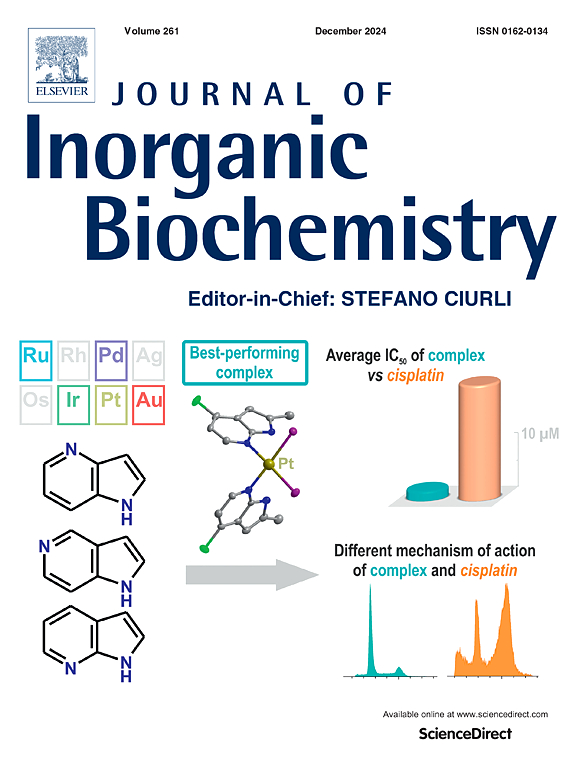Novel zinc(II) complexes bearing N,N,N-tridentate pyrimidine ligands as antitumor agents: Synthesis, characterization and antitumor evaluation
IF 3.2
2区 化学
Q2 BIOCHEMISTRY & MOLECULAR BIOLOGY
引用次数: 0
Abstract
Herein, a series of Zn(II) complexes (1–4) with a six-coordinate octahedral configuration were successfully designed and synthesized using pyrimidine-pyridine derivatives HL1-HL4. The structures of complexes 1–4 were systematically characterized by 1H NMR, IR, UV–Vis, X-ray single-crystal diffraction and XRD. MTT assays using selected tumor cell lines (MCF-7, BGC-823, A549, and BEL-7402) demonstrated that complexes 1–4 exhibited superior anti-proliferative activity compared to their corresponding ligands HL1-HL4 and the conventional chemotherapeutic agent cisplatin. Notably, complexes 1–4 showed particularly potent anti-proliferative effects against BGC-823 cells, with IC50 values ranging from 3.22 to 5.73 μM. Importantly, complexes 1–4 displayed significantly lower cytotoxicity toward normal human HL-7702 cells than cisplatin. Based on these findings, complexes 1 and 4, which exhibited the most potent activity against BGC - 823 cells, were selected for further investigation of their apoptosis - inducing mechanisms using Annexin V - FITC/PI double staining, AO/EB double staining, ROS fluorescence intensity detection, mitochondrial membrane potential assessment methods and the Western blot (WB).The results indicated that complexes 1 and 4 effectively suppressed tumor cell proliferation by triggering apoptosis, potentially via processes related to the production of reactive oxygen species (ROS) and mitochondrial impairment. Furthermore, the WB results indicate that complexes 1 and 4 induce tumor cell apoptosis by inhibiting Bcl-2 protein expression and promoting the generation of cleaved caspase-3. In summary, complexes 1–4 exhibit significant promise for the creation of antitumor therapies, providing a novel direction for further investigation and application in tumor treatment.

新型含N,N,N三齿嘧啶配体的锌(II)配合物抗肿瘤:合成、表征及抗肿瘤评价
本文以嘧啶-吡啶衍生物HL1-HL4为原料,成功设计并合成了一系列六坐标八面体构型的Zn(II)配合物(1-4)。通过1H NMR、IR、UV-Vis、x射线单晶衍射和XRD对配合物1-4的结构进行了系统表征。使用选定的肿瘤细胞系(MCF-7、BGC-823、A549和BEL-7402)进行的MTT试验表明,与相应的配体h1 - hl4和常规化疗药物顺铂相比,复合物1-4具有更好的抗增殖活性。值得注意的是,复合物1-4对BGC-823细胞表现出特别强的抗增殖作用,IC50值在3.22 ~ 5.73 μM之间。重要的是,复合物1-4对正常人HL-7702细胞的细胞毒性明显低于顺铂。在此基础上,采用Annexin V - FITC/PI双染色、AO/EB双染色、ROS荧光强度检测、线粒体膜电位评估方法和Western blot (WB)等方法,选择对BGC - 823细胞活性最强的复合物1和4,进一步探讨其诱导凋亡的机制。结果表明,复合物1和4通过触发细胞凋亡有效抑制肿瘤细胞增殖,可能通过活性氧(ROS)的产生和线粒体损伤相关的过程。此外,WB结果表明复合物1和4通过抑制Bcl-2蛋白表达和促进cleaved caspase-3的产生诱导肿瘤细胞凋亡。综上所述,复合物1-4在抗肿瘤治疗中具有重要的应用前景,为进一步研究和应用肿瘤治疗提供了新的方向。
本文章由计算机程序翻译,如有差异,请以英文原文为准。
求助全文
约1分钟内获得全文
求助全文
来源期刊

Journal of Inorganic Biochemistry
生物-生化与分子生物学
CiteScore
7.00
自引率
10.30%
发文量
336
审稿时长
41 days
期刊介绍:
The Journal of Inorganic Biochemistry is an established international forum for research in all aspects of Biological Inorganic Chemistry. Original papers of a high scientific level are published in the form of Articles (full length papers), Short Communications, Focused Reviews and Bioinorganic Methods. Topics include: the chemistry, structure and function of metalloenzymes; the interaction of inorganic ions and molecules with proteins and nucleic acids; the synthesis and properties of coordination complexes of biological interest including both structural and functional model systems; the function of metal- containing systems in the regulation of gene expression; the role of metals in medicine; the application of spectroscopic methods to determine the structure of metallobiomolecules; the preparation and characterization of metal-based biomaterials; and related systems. The emphasis of the Journal is on the structure and mechanism of action of metallobiomolecules.
 求助内容:
求助内容: 应助结果提醒方式:
应助结果提醒方式:


